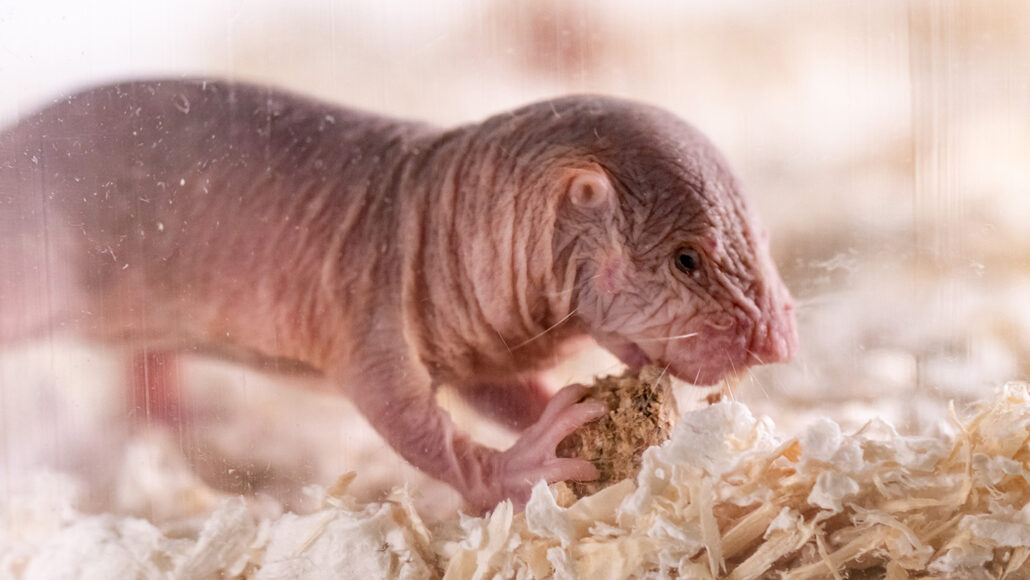Unique dialects help naked mole-rats tell friends from foes
Colonies use distinctive chirps that get passed down to new members

Naked mole-rats from different colonies have distinctive speech dialects. This likely helps keep colony bonds tight.
Felix Petermann/Max Delbrück Center
When two naked mole-rats meet, the sound of their chirps may signal friend from foe.
These social rodents are famous for their wrinkly, hairless bodies. But the sounds this chatty bunch makes are notable. Their underground burrows resound with near-constant chirps, grunts, squeaks and squeals. Now, computer algorithms are helping make sense of the din.
The chirps are distinct to each colony. Young pups learn their colony’s calls. The sounds help the mostly blind, stranger-fearing rodents know who belongs. That recognition keeps family units strong and working well together.
Alison Barker is a neuroscientist in Berlin, Germany. She works at the Max Delbrück Center for Molecular Medicine. Her team described its new results in the January 29 Science.
“Language is really important for extreme social behavior,” says Thomas Park. That’s true, he says, in humans, dolphins, elephants or birds. The new work, he says, now shows that’s true for naked mole-rats as well. Park, a biologist at the University of Illinois Chicago, wasn’t involved in the study.
Naked mole-rat groups seem more like ant or termite colonies than mammal societies. Every colony has a single queen. It’s supported by tens to hundreds of worker rats. Only the queen breeds. Workers dig elaborate underground tunnels in search of tubers to eat. Food is scarce in eastern Africa, where they live. So the rodents have to work together well to survive. And to protect their colonies, they’ll vigorously attack intruders.
Researchers had noted the rats’ raucous chatter before. But few actually studied it. “Naked mole-rats are incredibly cooperative and incredibly vocal,” says Barker “No one has really looked into how these two features influence one another.”
Friend vs. foe
Barker and her colleagues analyzed the rodents’ chatter. They used computer programs that employ a method known as machine learning. With this technique, computers can learn from examples and find patterns in data.
The team focused on “soft chirps” — a common type of call. Their computers analyzed more than 30,000 soft chirps. They had been recorded from seven laboratory colonies over two years. Each colony had a unique sound, the results showed. The biggest difference was in a chirp’s frequency, which affects its pitch. How much that frequency changes within a single chirp also varied.
Naked mole-rats pick up on these differences. They reply to the sounds of their own colony with frequent chirping. But the rats largely ignore foreign dialects. “That surprised us,” Barker says. “Soft chirps might signal that a naked mole-rat belongs to the colony.” The animals aren’t just responding to voices they’ve heard before, either. Fake calls designed to match a colony’s dialect also got a response.
Mole-rat greeting
Naked mole-rats often greet each other with a soft chirp, which can be used to communicate individual and colony identity. Different colonies have distinctive dialects, often varying in frequency, as can be heard by comparing these soft chirps from two separate colonies.
Are these dialects learned? Or encoded in the animals’ genes? A bit of luck helped Barker’s group figure answer those questions. Most naked mole-rat colonies reject outsiders. Sometimes, though, a colony will adopt pups from other groups. In their lab, multiple rat groups had new litters around the same time. So the researchers switched three youngsters to new colonies.
If a rat’s dialect stems from its genes, the adoptees should sound like outsiders. But the transplanted pups all sounded like their new families. That means they learned the dialects after joining the new colonies, the researchers conclude. And the younger a pup was at the time it was adopted, the more closely it matched its new home’s chirp.
Three pups may not sound like much, “but these are really difficult experiments to do,” says Chris Faulkes. Not involved in the study, he is an evolutionary biologist in England at Queen Mary University of London. The results strongly suggest that naked mole-rats learn their chirp dialects, he says — much as do people, dolphins and some birds.
A colony’s sound is distinct. But it can change — such as when a queen dies. Before she is replaced, the dialect starts to weaken, the researchers found. The chirps become more variable. Once a new queen emerges, the colony’s sound again starts to match. So, queens may somehow control the “voice” with which her colony speaks.
Dialects probably help naked mole-rat societies cooperate, Barker says. But they may also be a way queens manage their colonies. They suppress individual voices for the good of the group.
Communication and cooperation benefit the colony. But those come at a cost. “Individuals are rigidly controlled in their behavior by the queen,” Barker says. “It gives them a huge survival advantage, but it’s a bit like living in an oppressive regime.”







